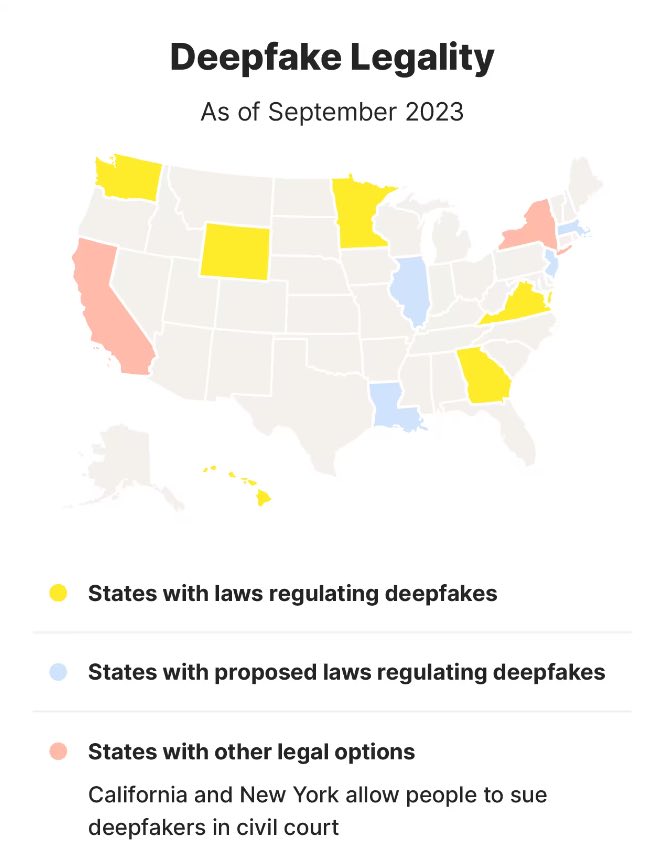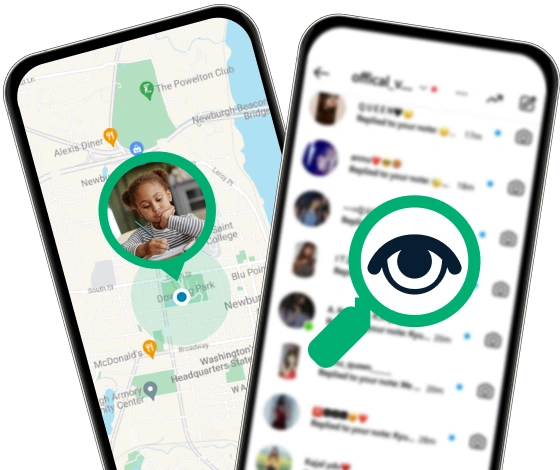What are deepfakes? Simply put, they’re wolves in sheep’s clothing – fake videos and photos that seem genuine. Although there are cases when deepfakes are used for entertainment purposes, there are risks associated with them. So, the question arises: “If it is possible to create a virtual human clone in a matter of minutes, how can we know what is real and what is a scam”?
This guide will break down deepfakes in simple terms, explaining how they work and why they’re a concern. Keep reading to understand how to spot them and protect yourself from digital manipulation.
What Is a Deepfake?
A deepfake is a synthetic photo or video created using AI (artificial intelligence) that looks almost indistinguishable from the real deal. A deepfake can depict people saying or doing something they never actually did. For example, you can take a video of your favorite singer and put new words in their mouth or take a photo and change a face.
How to Make Deepfakes?
Deepfake is made using the power of deepfake technology (a combination of two algorithms: generators and discriminators) to create them.
Generators analyze vast amounts of data, such as images and videos of a target person, to learn their facial expressions, speech patterns, etc. They put this information on top of other videos or pictures, mixing the person’s features with what they want to change. Then, discriminators evaluate the content for realism and feed its findings back into the generators for further refinement. This makes a new video or picture look real, showing the person doing or saying something they didn’t do.
Who Uses Deepfakes?
Deepfakes is a useful tool that is used by researchers, hobbyists, visual effects studios, cyber attackers, and porn producers. Governments also use it for online strategies, like discrediting extremist groups or contacting the target individuals.
With easy access to deepfake software, many people can use this advanced technology to satisfy their purposes. And while some may use it for entertainment or marketing purposes, others might use deepfakes for malicious intentions, like spreading lies or ruining someone’s reputation. So, staying alert is essential, and knowing how you might encounter deepfakes online is crucial.
How to Detect a Deepfake?
Well, with so many deepfakes online, how to spot a deepfake from a real thing? Although no universal model could answer this question, you need not be an expert to distinguish real from fake.
- Think again: Look at the photo or video again. Do not hurry to share it with the public. If you consider it may not be real, do not share it.
- Do a brief research on a headline: If you are uncertain about the trustworthiness of the information you have seen, do not hesitate to research and check its credibility through reliable sources. No similarities? It is a deepfake.
- Try a reverse image search: Are you uncertain whether it is a real or fake story? Use Google or DuckDuckGo to search to describe it, find another version, and compare both.
Here are a few considerable deepfake examples you have to pay attention to:
– strange “jumps” in a video;
– low-quality audio;
– change of voice emphasis;
– blurred spots;
– perfectly symmetrical face;
– difference in appearance;
– and more. - Check mimic: Look at the teller’s mouth and lips and check whether the sounds they produce are made the way they should be. Repeat these words in front of the mirror to compare how they are produced. If you see differences in lip synchronization, it is one of the signs of deepfake videos.
- Facial expressions: Deepfake photos and videos often contain face manipulations that are difficult to notice (changes to facial features).
- Skin agedness: Pay attention to skin smoothness on the cheeks, forehead, and eyes. Are they the same? If yes, it’s another sign of a deepfake.
- Absence of shadows: Look at eyebrows, nose, and eyes. There should be a natural physics of lighting. Absent? The answer is clear.
- Hair: Analyze whether the person’s hair looks natural. Is it too long, short or maybe has another structure? Deepfake might add or remove sideburns, mustache, or beard.
- Facial moles: Although they’re difficult to notice, that does not mean it is impossible. Check the moles and ask yourself: “Do they look real?”
- Frequency of blinking: In 2018, US researchers discovered that if the person on the video blinks unnaturally too often or, conversely, too rarely, it’s a deepfake.
- Mismatched skin color: Pay attention to the person’s skin color and compare its tone between different parts of the face or body.
- Unusual eye contact: One of the signs of a deepfake is the absence of natural eye contact that looks lifeless or strange.
- Unnatural head movements: Look at the speaker’s head movements. Does it look unnatural?
- Makeup: Do the makeup or appearance features look unrealistic or too smooth (e.g., too smooth skin or perfectly white teeth)?
- Lack of natural emotions: Deepfakes frequently lack life and natural human emotions. Does the speaker look too robotic or emotionless? Yeah, it’s a deepfake.
Is Deepfake Illegal in the United States?
According to the 2019 ABC News report, Henry Ajder, a synthetic media expert, reported that 96% of the 14K deepfake videos found online were porn. Although several years ago, to create AI-generated content, a certain level of skills was required, now, with the help of special deepfake apps, it’s become as easy as A, B, C.
Dr. Mary Anne Franks, the law professor and the president of the Cyber Civil Rights Initiative responsible for struggling with online abuse, said that once content, whether real or fabricated, was shared publicly, undoing the harm could be incredibly difficult.
For this reason, Morelle presented to Congress a bill to make deepfakes illegal in the US in 2023. Although there is no federal law governing deepfakes as of now, a few states consider deepfake creation illegal, while distributing them is illegal in other states.

In What Purposes Are the Deepfakes Used for?
Most of the deepfakes are used for pornographic purposes. And, frequently, the victims of deepfakes are female celebrities. With this new tech, anyone, even those not so tech-savvy, can whip up deepfake videos using just a few photos. These fake videos will likely start popping up outside the realm of celebrities, possibly worsening the problem of revenge porn.
How to Solve the Problem?
One of the best solutions, how ironic it would not sound, is using artificial intelligence. It can help spot deep fake content. However, there is a significant gap in the system’s performance: it works well only for celebrities because the AI can train for hours using freely available content online.
Interestingly, in 2020, the first Deepfake Detection Challenge Dataset was designed to spur the creation of new ways of detecting and preventing AI-manipulated media. The dataset driven by Amazon, Microsoft, and Facebook includes research teams around the globe competing for supremacy in deepfake detection.
Using digital watermarks is another way to protect your content from becoming a deepfake. Although this method is not 100% reliable, blockchain-based online ledger systems could securely store videos, pictures, and audio records, making it possible to verify their origins and any changes.
Are Deepfakes Always Harmful?
Although most videos are created with a harmful intention, they do have some positive potential – CereProc, which makes digital voices. So, using it, you can restore people’s voices in case of loss because of age, accident, or disease. Using this method, you can animate galleries and museums. You can send birthday contractions to your close friends from their cult figures (famous singers, sportsmen, bloggers, or other celebrities).
Deepfakes vs. Shallowfakes
Shallowfakes are fake videos, pictures, or documents created without AI. The worst thing is that any bad actor can create shallowfakes without experience using simple editing tools, such as basic video or image editing software. They can include changes such as slowing down or speeding up footage, combining different clips, or adding basic filters or effects. Consequently, they are easier to detect than deepfakes. Nevertheless, they can still be risky, especially in spreading fake news or trying to change what people think. However, they’re not as powerful as deepfakes in doing this.
Tips: How to Protect Yourself and Your Loved Ones from Deepfakes?
Well, with so many risks associated with deepfake usage, it’s getting harder to detect a deep fake video, but how can you protect yourself and your dearest ones from it? Here are a few tips that will help you with it.
- Use special applications: If you want to protect your kid, spouse, close relative, or friend from any possible deepfake attack, install uMobix on their cell phone. The app will provide you full access to the target’s SMS, MMS, emails, social media messages, and those sent or received via IM apps, enabling you to detect any sign of deepfake and respond quickly. Moreover, this tool would be a perfect solution if you want to strengthen parental controls over your child.
- Share with care: Be attentive when you share your private data online, and avoid sharing high-quality photos or videos with many people on social media. Share the private content only with those you trust.
- Enable privacy settings: Restrict who can view your photos and videos online. It will protect you from phishing scam attacks, blackmail, child identity theft, bullying, and other online dangers.
- Watermark content: Deepfake creators will be demotivated to use the content containing watermarks, as it would require more time and effort to make deepfake content.
- Consider multifactor authentication: Adding an extra security level to your account will prevent unauthorized access to your profile, thereby reducing the risks that someone may access it.
- Use strong passwords: It’s a golden rule for everyone with a digital profile. Using the “1111” or “ABC” combination in your password is not the case. Make it strong, and include numbers, symbols, capital, and small letters to strengthen them.
- Don’t reply to unknown senders: If you receive direct messages, texts, or phone calls from unknown sources with CTA (like “BUY NOW!” or “GET YOUR PRIZE!”) – ignore them and DON’T reply.
- Report about deepfake accident: If you have become a victim of deepfake, report about this to federal law enforcement.
FAQ
In short, no, it is not. However, deepfakes are used for phishing scams and can lead to identity theft. Deepfakes are also used to manipulate politics, spread false information, blackmail celebrities, and create unwanted explicit content, increasing the risks of deception, exploitation, and privacy breaches in our digital world.
You can use AI to detect them or look for suspicious things like lighting, strange colors, absence of shadows, lifeless eye contact, odd movements, unnatural features or makeup, mismatched skin color, lack of natural emotions, etc., to help you detect a deepfake video or photo.
Anyone can become a victim of deepfake attacks. Therefore, it is highly recommended to be cautious when sharing your media content online or letting someone take a photo or video with you.





